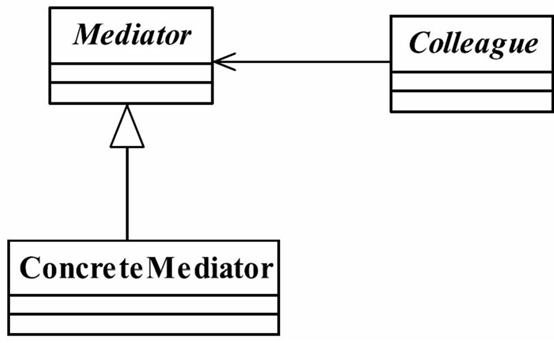【設計模式】中介者模式
1、 定義
1.1 標準定義
中介者模式的定義為:Define an object that encapsulates how a set of objectsinteract.Mediator promotes loose coupling by keeping objects from referring to each other explicitly,and it lets you vary their interaction independently.(用一個中介對象封裝一系列的對象交互, 中介者使各對象不需要顯示地相互作用, 而使其耦合松散,而且可以獨立地改變它們之間的交互。)
1.2 通用類圖

● Mediator 抽象中介者角色
抽象中介者角色定義統一的接口,用於各同事角色之間的通信。
● Concrete Mediator 具體中介者角色
具體中介者角色通過協調各同事角色實現協作行為,因此它必須依賴於各個同事角色。
● Colleague 同事角色
每一個同事角色都知道中介者角色,而且與其他的同事角色通信的時候,一定要通過中介者角色協作。每個同事類的行為分為兩種:一種是同事本身的行為,比如改變對象本身的狀態,處理自己的行為等,這種行為叫做自發行為(
Self-Method),與其他的同事類或中介者沒有任何的依賴;第二種是必須依賴中介者才能完成的行為,叫做依賴方法(DepMethod)。
2、實現
2.1 類圖

Colleage抽象同事類,而ConcreteColleage是具體同事類,每個具體同事只知道自己的行為,而不了解其他同事類的情況,但它們卻都認識中介者對象,Mediator是抽象中介者,定義了同事對象到中介者對象的接口,ConcreteMediator是具體中介者對象,實現抽象類的方法,它需要知道所有具體同事類,並從具體同事接受消息,向具體同事對象發出命令。
Colleage類,抽象同事類
Mediator類,抽象中介者類
說明:
1. Mediator 模式中,每個Colleague 維護一個 Mediator,當要進行通信時,每個具體的 Colleague 直接向ConcreteMediator 發信息,至於信息發到哪裏,則由 ConcreteMediator 來決定。
2. ConcreteColleagueA 和 ConcreteColleagueB 不必維護對各自的引用,甚至它們也不知道各個的存在。
2.2 代碼
2.2.1 mediator類
// Mediator.h #ifndef _MEDIATOR_H_ #define _MEDIATOR_H_ #include <string> using namespace std; class Mediator; class Colleage { public: virtual ~Colleage(); virtual void SetMediator(Mediator*); virtual void SendMsg(string) = 0; virtual void GetMsg(string) = 0; protected: Colleage(Mediator*); Mediator* _mediator; private: }; class ConcreteColleageA : public Colleage { public: ~ConcreteColleageA(); ConcreteColleageA(Mediator*); virtual void SendMsg(string msg); virtual void GetMsg(string); protected: private: }; class ConcreteColleageB : public Colleage { public: ~ConcreteColleageB(); ConcreteColleageB(Mediator*); virtual void SendMsg(string msg); virtual void GetMsg(string); protected: private: }; class Mediator { public: virtual ~Mediator(); virtual void SendMsg(string,Colleage*) = 0; protected: Mediator(); private: }; class ConcreteMediator : public Mediator { public: ConcreteMediator(); ~ConcreteMediator(); void SetColleageA(Colleage*); void SetColleageB(Colleage*); virtual void SendMsg(string msg,Colleage*); protected: private: Colleage* m_ColleageA; Colleage* m_ColleageB; }; #endif
// Mediator.cpp #include "Mediator.h" #include <iostream> #include <string> using namespace std; Colleage::Colleage(Mediator* pMediator) { this->_mediator = pMediator; } Colleage::~Colleage(){} void Colleage::SetMediator(Mediator* pMediator) { this->_mediator = pMediator; } ConcreteColleageA::ConcreteColleageA(Mediator* pMediator) : Colleage(pMediator){} ConcreteColleageA::~ConcreteColleageA(){} void ConcreteColleageA::SendMsg(string msg) { this->_mediator->SendMsg(msg,this); } void ConcreteColleageA::GetMsg(string msg) { cout << "ConcreteColleageA Receive:"<< msg << endl; } ConcreteColleageB::ConcreteColleageB(Mediator* pMediator) : Colleage(pMediator){} ConcreteColleageB::~ConcreteColleageB(){} void ConcreteColleageB::SendMsg(string msg) { this->_mediator->SendMsg(msg,this); } void ConcreteColleageB::GetMsg(string msg) { cout << "ConcreteColleageB Receive:" << msg << endl; } Mediator::Mediator(){} Mediator::~Mediator(){} ConcreteMediator::ConcreteMediator(){} ConcreteMediator::~ConcreteMediator(){} void ConcreteMediator::SetColleageA(Colleage* p) { this->m_ColleageA = p; } void ConcreteMediator::SetColleageB(Colleage* p) { this->m_ColleageB = p; } void ConcreteMediator::SendMsg(string msg,Colleage* p) { if(p == this->m_ColleageA) { this->m_ColleageB->GetMsg(msg); } else if(p == this->m_ColleageB) { this->m_ColleageA->GetMsg(msg); } }
2.2.3 調用
// mian.cpp #include "Mediator.h" int main() { ConcreteMediator* pMediator = new ConcreteMediator(); Colleage* p1 = new ConcreteColleageA(pMediator); Colleage* p2 = new ConcreteColleageB(pMediator); pMediator->SetColleageA(p1); pMediator->SetColleageB(p2); p1->SendMsg("xxx"); p2->SendMsg("ooo"); return 0; }
3、優缺點
3.1 優點
中介者模式的優點就是減少類間的依賴,把原有的一對多的依賴變成了一對一的依賴,同事類只依賴中介者,減少了依賴,當然同時也降低了類間的耦合。
3.2 缺點
中介者模式的缺點就是中介者會膨脹得很大,而且邏輯復雜,原本N個對象直接的相互依賴關系轉換為中介者和同事類的依賴關系,同事類越多,中介者的邏輯就越復雜。
4、應用
● N個對象之間產生了相互的依賴關系( N>2) 。
● 多個對象有依賴關系, 但是依賴的行為尚不確定或者有發生改變的可能, 在這種情況下一般建議采用中介者模式, 降低變更引起的風險擴散。
● 產品開發。一個明顯的例子就是MVC框架,把中介者模式應用到產品中,可以提升產品的性能和擴展性,但是對於項目開發就未必, 因為項目是以交付投產為目標,而產品則是以穩定、高效、擴展為宗旨。
【設計模式】中介者模式
